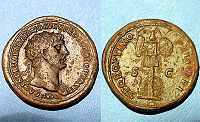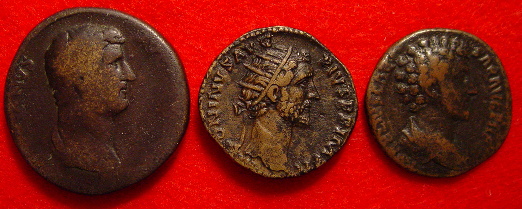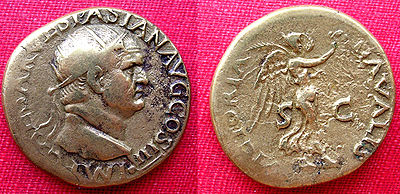
Dupondius
Encyclopedia

Brass
Brass is an alloy of copper and zinc; the proportions of zinc and copper can be varied to create a range of brasses with varying properties.In comparison, bronze is principally an alloy of copper and tin...
coin
Coin
A coin is a piece of hard material that is standardized in weight, is produced in large quantities in order to facilitate trade, and primarily can be used as a legal tender token for commerce in the designated country, region, or territory....
used during the Roman Empire
Roman Empire
The Roman Empire was the post-Republican period of the ancient Roman civilization, characterised by an autocratic form of government and large territorial holdings in Europe and around the Mediterranean....
and Roman Republic
Roman Republic
The Roman Republic was the period of the ancient Roman civilization where the government operated as a republic. It began with the overthrow of the Roman monarchy, traditionally dated around 508 BC, and its replacement by a government headed by two consuls, elected annually by the citizens and...
valued at 2 asses
As (coin)
The , also assarius was a bronze, and later copper, coin used during the Roman Republic and Roman Empire.- Republican era coinage :...
(1/2 of a sestertius
Sestertius
The sestertius, or sesterce, was an ancient Roman coin. During the Roman Republic it was a small, silver coin issued only on rare occasions...
or 1/8 of a denarius
Denarius
In the Roman currency system, the denarius was a small silver coin first minted in 211 BC. It was the most common coin produced for circulation but was slowly debased until its replacement by the antoninianus...
).
The dupondius was introduced during the Roman Republic as a large cast coin, although even at introduction it weighed less than 2 pounds. The coin featured the bust of Roma
Roma (mythology)
In traditional Roman religion, Roma was a female deity who personifed the city of Rome and more broadly, the Roman state. Her image appears on the base of the column of Antoninus Pius.-Problems in earliest attestation:...
on the obverse and a six-spoked wheel
Wheel
A wheel is a device that allows heavy objects to be moved easily through rotating on an axle through its center, facilitating movement or transportation while supporting a load, or performing labor in machines. Common examples found in transport applications. A wheel, together with an axle,...
on the reverse. This denomination was not minted during the Republican
Roman Republic
The Roman Republic was the period of the ancient Roman civilization where the government operated as a republic. It began with the overthrow of the Roman monarchy, traditionally dated around 508 BC, and its replacement by a government headed by two consuls, elected annually by the citizens and...
Era.

23 BC
Year 23 BC was either a common year starting on Saturday or Sunday or a leap year starting on Friday, Saturday or Sunday of the Julian calendar and a common year starting on Friday of the Proleptic Julian calendar...
, the sestertius and dupondius were produced in a golden colored copper-alloy called orichalcum
Orichalcum
Orichalcum is a metal mentioned in several ancient writings, most notably the story of Atlantis as recounted in the Critias dialogue, recorded by Plato. According to Critias, orichalcum was considered second only to gold in value, and was found and mined in many parts of Atlantis in ancient times....
by the Romans and numismatists, and by us brass
Brass
Brass is an alloy of copper and zinc; the proportions of zinc and copper can be varied to create a range of brasses with varying properties.In comparison, bronze is principally an alloy of copper and tin...
, while lower denominations were produced out of reddish copper. However, some dupondi were made from copper
Copper
Copper is a chemical element with the symbol Cu and atomic number 29. It is a ductile metal with very high thermal and electrical conductivity. Pure copper is soft and malleable; an exposed surface has a reddish-orange tarnish...
under Augustus
Augustus
Augustus ;23 September 63 BC – 19 August AD 14) is considered the first emperor of the Roman Empire, which he ruled alone from 27 BC until his death in 14 AD.The dates of his rule are contemporary dates; Augustus lived under two calendars, the Roman Republican until 45 BC, and the Julian...
, while under Nero
Nero
Nero , was Roman Emperor from 54 to 68, and the last in the Julio-Claudian dynasty. Nero was adopted by his great-uncle Claudius to become his heir and successor, and succeeded to the throne in 54 following Claudius' death....
some of the as
AS
AS may refer to:-Science and technology:* A. S. , a small French car in the 1920s* A.S. Design, a French car* A. S. , a Dutch truck made in the 1920s to 50s* AS One, a German-build, but Liechtenstein-based sportscar...
denomination were made from orichalcum
Orichalcum
Orichalcum is a metal mentioned in several ancient writings, most notably the story of Atlantis as recounted in the Critias dialogue, recorded by Plato. According to Critias, orichalcum was considered second only to gold in value, and was found and mined in many parts of Atlantis in ancient times....
instead of copper
Copper
Copper is a chemical element with the symbol Cu and atomic number 29. It is a ductile metal with very high thermal and electrical conductivity. Pure copper is soft and malleable; an exposed surface has a reddish-orange tarnish...
. The latter can only be distinguished by their smaller size and the metal.
The dupondius was normally further distinguished from the similarly sized as
As (coin)
The , also assarius was a bronze, and later copper, coin used during the Roman Republic and Roman Empire.- Republican era coinage :...
with the addition of a radiate crown to the bust of the emperor in 66
66
Year 66 was a common year starting on Wednesday of the Julian calendar. At the time, it was known as the Year of the Consulship of Telesinus and Paullinus...
AD during the reign of Nero
Nero
Nero , was Roman Emperor from 54 to 68, and the last in the Julio-Claudian dynasty. Nero was adopted by his great-uncle Claudius to become his heir and successor, and succeeded to the throne in 54 following Claudius' death....
. Using a radiate crown to indicate double value was also used on the antoninianus
Antoninianus
The antoninianus was a coin used during the Roman Empire thought to have been valued at 2 denarii. It was initially silver, but was slowly debased to bronze. The coin was introduced by Caracalla in early 215 and was a silver coin similar to the denarius except that it was slightly larger and...
(double denarius) and double sestertius
Double sestertius
The double sestertius was a large Roman coin made of orichalcum first issued by Trajan Decius in AD 249-251, as a response to the inflationary pressures of the time which had devalued the buying power of the conventional sestertius...
. Since dupondii minted prior to and during the reign of Nero
Nero
Nero , was Roman Emperor from 54 to 68, and the last in the Julio-Claudian dynasty. Nero was adopted by his great-uncle Claudius to become his heir and successor, and succeeded to the throne in 54 following Claudius' death....
, and occasionally under later rulers, lack the radiate crown, it is often hard to distinguish between the as
As (coin)
The , also assarius was a bronze, and later copper, coin used during the Roman Republic and Roman Empire.- Republican era coinage :...
and the dupondius due to heavy patina
Patina
Patina is a tarnish that forms on the surface of bronze and similar metals ; a sheen on wooden furniture produced by age, wear, and polishing; or any such acquired change of a surface through age and exposure...
tion which obscures the coin's original color.
An extremely rare dupondius from the reign of Marcus Aurelius, dated to AD 154 or 155 and in excellent condition, was discovered in 2007 at the archeological site in Draper's Gardens
Draper's Gardens
Drapers Gardens is a site in the City of London at the junction of Throgmorton Avenue and Copthall Avenue on land owned by the Drapers' Company, originally forming gardens but used for major office blocks from the 1960s.-Seifert skyscraper:...
, London.


Roman currency
The Roman currency during most of the Roman Republic and the western half of the Roman Empire consisted of coins including the aureus , the denarius , the sestertius , the dupondius , and the as...
.

